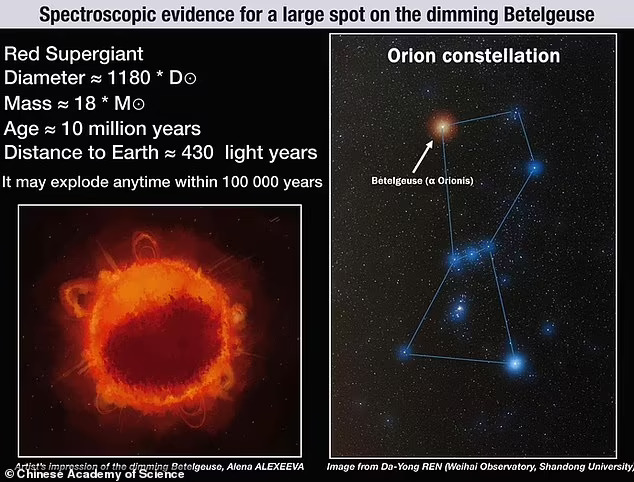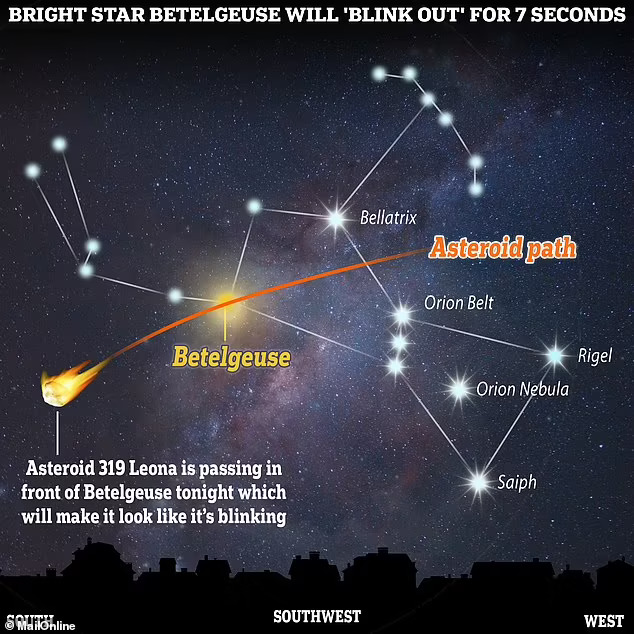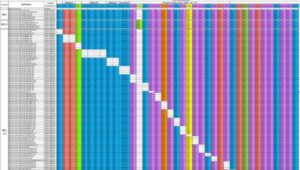Stargazers have a ‘once-in-a-lifetime opportunity’ to see a rare astronomical event tonight.
But you’ll have to be up during the small hours to witness it – and if you blink, you really could miss it.
An asteroid known as 319 Leona is set to pass in front of a faraway star called Betelgeuse, famous for its bright red tint and unpredictable behaviour.
This so-called ‘occultation’ will result in the star briefly disappearing, as if it’s been blotted out of the night sky by the almighty, before suddenly reappearing.
The event will happen not long after 1am UTC, in the early hours of Tuesday (December 12), but whether or not you’ll see it depends on where you are in the world.
Astrophysicist Miguel Montargès at the Paris Observatory has described the ‘exceptional’ event as a ‘once-in-a-lifetime opportunity’.
The event will only be visible along a narrow path (known as an occultation track) that goes through parts of Asia, southern Europe, and southern parts of North America – but not the UK.
‘The asteroid (Leona) will appear to move from west to east in the sky, and for northern hemisphere observers that means right to left,’ Dr Robert Massey at the Royal Astronomical Society told MailOnline.
‘It will not be visible from the UK – in Europe the occultation track runs across the Mediterranean, including southern Italy, southern Spain and southern Portugal, and also Florida and Mexico.’
According to The Sky at Night, Betelgeuse will be visible for seven seconds, but it could be longer or shorter depending on your location.
‘Each observer will see an event lasting 5 to 15 seconds,’ Dr Massey said.
‘The predicted time along the whole occultation track across the Earth is from 01:08 to 01:26 GMT on December 12.’


Betelgeuse – usually the tenth-brightest star in the night’s sky – is 950 times the size of the sun and 642.5 light years away from Earth.
It is a red giant – a dying star in the final stages of stellar evolution – in the famous Orion constellation, named after legendary hunter in Greek mythology.
Betelgeuse is easy to spot, not only because of its brightness and its red tint.
It forms the ‘right shoulder’ of the constellation Orion (or left shoulder, as seen from Earth) and is viewable just top left of the famous belt – the line of three stars.
Right now, Betelgeuse is being approached by the much smaller 319 Leona asteroid, which is just 45 miles (70 km) in diameter.
Because the asteroid is small, to see Betelgeuse covered you have to be in a place where the star and asteroid are in almost perfect alignment with your location.
That’s why its occultation track is so narrow, and why not the whole world will see it, according to Dr Massey.
For those unable to see the event with their own eyes, they don’t have to completely miss out.
CLICK HERE TO READ MORE FROM THE REPUBLICAN VOICE

That’s because the Virtual Telescope Project – which uses powerful robotic telescopes to broadcast cosmic events – is streaming it live online.
The livestream, available on YouTube, will start at 01:00 GMT and the occultation should be complete within half an hour.
Gianluca Masi, director of the Virtual Telescope Project, said the rare event could help experts study both the star and the asteroid.
‘These kind of occultations are very useful to constrain the shape of the asteroid involved,’ Masi said in a statement.
‘Here, we hope to even investigate the surface of the involved star, too – Betelgeuse.
‘It is a large red supergiant and while Leona will move in front of it as seen from Earth, we will be hopefully able to learn more about its large convective cells, driving its variable brightness.’
Betelgeuse experienced a massive dip in brightness in 2019, but this was not to do with any asteroid passing in front of it.
Scientists said last year it was caused by a combination of sudden cooling and dust condensing nearby the star.
source: dailymail.co.uk/One-brightest-stars-night-sky-DISAPPEAR-7-seconds























